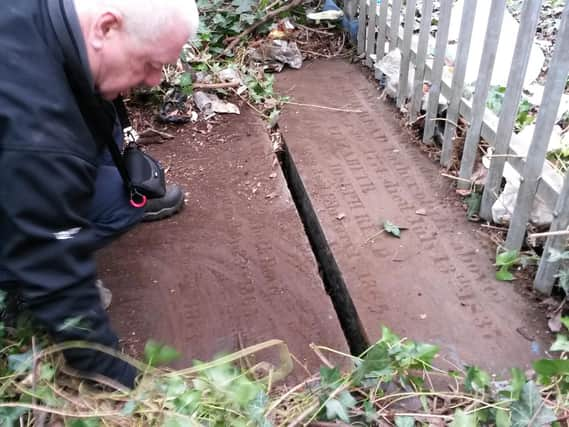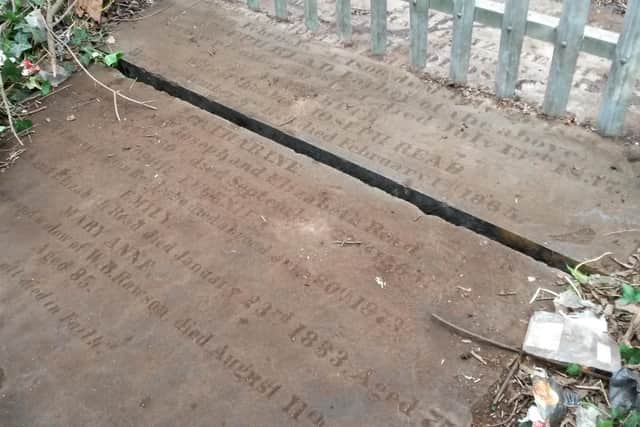Historic discovery of Sheffield anti-slavery campaigner's grave


Mary Anne Rawson was a key figure in the fight to abolish slavery in the UK in the 19th century.
The Sheffield-born activist is buried in the former Zion Chapel graveyard in Attercliffe. But the land has been forgotten over the years, becoming overgrown and litter-strewn.


Advertisement
Hide AdAdvertisement
Hide AdThe United Reformed Church is now seeking to sell the plot. But Penny Rea, of the Friends of Wincobank Hill group, believes its links to Sheffield’s role in abolishing slavery means it should be preserved.
The tangle of weeds had become so impenetrable the likelihood of finding Mary Anne’s grave seemed slim.
But that all changed when a group of volunteers armed with garden tools and determination managed to uncover the grave of Mary Anne and her siblings.
The question now is how it can be maintained and promoted to make more people aware of one of Sheffield’s most important daughters.


Advertisement
Hide AdAdvertisement
Hide AdBelow, volunteer Penny Rea gives her first hand account of the discovery.
“I am recovering from the shock and exhilaration of actually finding Mary Anne’s grave amidst what can only be described as a jungle.
"The place was really overgrown – like something out of Sleeping Beauty.
"Ken Riley, of Rileys Machine Tools, who owns the adjacent land where the chapel stood, had kindly cleared a pathway for us to get close to the graves. Looking for a needle in a haystack didn’t come near as a description for such a seemingly impossible task.
Advertisement
Hide AdAdvertisement
Hide Ad"So it really was quite extraordinary when one of our expedition party, Dave Roberts found Mary Anne’s grave under our feet when we were standing at the edge wondering about a more prominent and fancy grave.
"Dave realised he was standing on solid ground, scraped back the ground cover and immediately revealed the name Read.
"I was so amazed. A steel fence has been erected across the top section resulting in part of the memorial stone being in a passageway, but nevertheless it was possible to scrape off the soil and vegetation to expose two enormous stone slabs neatly and plainly inscribed with the names and dates of eight members of the Read family.
"Curiously, the last of the Read children to be born, baby Julia, aged 11 months, was the first to be buried in 1819 and the firstborn, Mary Anne, outlived them all and died aged 85 in 1887.
Advertisement
Hide AdAdvertisement
Hide Ad"Ken Riley told me that there used to be an arched roof over this grave with a little chapel-like building at the back.
"This was demolished about twenty years ago when the fence was put in place to protect the rest of the graves and reduce dumping on the land. If any of your readers recall this building and could draw a diagram or sketch from memory, or better still have a photo they could share, that would be wonderful.
"Mr Riley really is a lovely man who has tried to look after the grave yard. He had erected a special gate and laid a path down the side of the land to allow access but people stopped visiting and it became overgrown.
"It seems that there are about 30 more graves which seem to be intact and in very good condition, perhaps because they have been protected from the elements by the overgrown foliage.
"They look very beautiful in that peaceful place.
Advertisement
Hide AdAdvertisement
Hide Ad"I am planning to go back with helpers to clear and record the names on the other stones and we could send you those names in case any readers are related.
"In the meantime I am planning to meet with the Synod Trust who have put the land up for sale to see what can be done to preserve this wonderful space.”
Mary Anne Rawson factfile:
Mary Anne Rawson lived from 1801 to 1887, and spent most of her life at Wincobank Hall, in Sheffield
She was a founding member in 1825 of the Sheffield Female Anti-Slavery Society, which campaigned to end bondage in the British Empire, and she led a boycott of goods produced by slaves
Advertisement
Hide AdAdvertisement
Hide AdIn 1837, she became secretary of the Sheffield Ladies Association for the Universal Abolition of Slavery, which fought to free enslaved workers across the world
She was a keen philanthropist and helped set up a Sunday school and day school within the grounds of Wincobank Hall
Her body lies within her family vault in the former Zion Chapel graveyard on in Zion Lane in Attercliffe
Today’s top stories:
Advertisement
Hide AdAdvertisement
Hide AdAdvertisement
Hide AdAdvertisement
Hide Ad